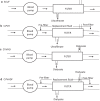Management of Acute Kidney Injury in Critically Ill Children
- PMID: 36859513
- PMCID: PMC9977639
- DOI: 10.1007/s12098-023-04483-2
Management of Acute Kidney Injury in Critically Ill Children
Abstract
Acute kidney injury (AKI) is common in critically ill patients, affecting almost one in four critically ill children and one in three neonates. Higher stages of AKI portend worse outcomes. Identifying AKI timely and instituting appropriate measures to prevent and manage severe AKI is important, since it is independently associated with mortality. Methods to predict severe AKI should be applied to all critically ill patients. Assessment of volume status to prevent the development of fluid overload is useful to prevent adverse outcomes. Patients with metabolic or clinical complications of AKI need prompt kidney replacement therapy (KRT). Various modes of KRT are available, and the choice of modality depends most on the technical competence of the center, patient size, and hemodynamic stability. Given the significant risk of chronic kidney disease, patients with AKI require long-term follow-up. It is important to focus on improving awareness about AKI, incorporate AKI prevention as a quality initiative, and improve detection, prevention, and management of AKI with the aim of reducing acute and long-term morbidity and mortality.
Keywords: AKI; Dialysis; Kidney replacement therapy; Pediatric.
© 2023. The Author(s), under exclusive licence to Dr. K C Chaudhuri Foundation.
Conflict of interest statement
None.
Figures

Similar articles
-
Continuous renal replacement therapy in neonates and children: what does the pediatrician need to know? An overview from the Critical Care Nephrology Section of the European Society of Paediatric and Neonatal Intensive Care (ESPNIC).Eur J Pediatr. 2024 Feb;183(2):529-541. doi: 10.1007/s00431-023-05318-0. Epub 2023 Nov 17. Eur J Pediatr. 2024. PMID: 37975941 Free PMC article. Review.
-
Hyperchloremia and association with acute kidney injury in critically ill children.Pediatr Nephrol. 2023 Jul;38(7):2233-2242. doi: 10.1007/s00467-022-05823-8. Epub 2022 Nov 21. Pediatr Nephrol. 2023. PMID: 36409366
-
Kidney Support in Children using an Ultrafiltration Device: A Multicenter, Retrospective Study.Clin J Am Soc Nephrol. 2019 Oct 7;14(10):1432-1440. doi: 10.2215/CJN.03240319. Epub 2019 Aug 28. Clin J Am Soc Nephrol. 2019. PMID: 31462396 Free PMC article.
-
The Causes of Acute Kidney Injury in Critically Ill Children Who Needs Renal Replacement Therapy.Med Arch. 2022 Apr;76(2):90-95. doi: 10.5455/medarh.2022.76.90-95. Med Arch. 2022. PMID: 35774037 Free PMC article.
-
Acute Kidney Injury in the Critically Ill.Surg Clin North Am. 2017 Dec;97(6):1399-1418. doi: 10.1016/j.suc.2017.07.004. Surg Clin North Am. 2017. PMID: 29132515 Review.
Cited by
-
Experience of continuous kidney replacement therapy in a tertiary care unit of a lower-middle-income country.Pediatr Nephrol. 2025 Jun;40(6):2083-2090. doi: 10.1007/s00467-025-06674-9. Epub 2025 Jan 31. Pediatr Nephrol. 2025. PMID: 39888434
References
-
- Kidney Disease: Improving Global Outcomes (KDIGO) Acute Kidney Injury Work Group. KDIGO clinical practice guideline for acute kidney injury. Kidney Int Suppl. 2012;2:1–138.
Publication types
MeSH terms
LinkOut - more resources
Full Text Sources
Medical
Research Materials

